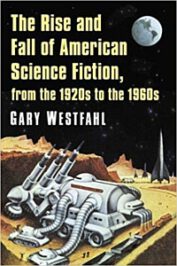Even though a title such as “The Rise and Fall” usually has readers prepared for a large, heavy volume that will provide audiences with loads of information amassed in a mostly boring manner, Westfahl’s book on a literary genre differs from that stereotype.
In fact, the four major parts (and a short epilogue) read very  much like a collection of concise essays. And actually, this is owed much to their origin as distinctive publications, extended versions of previous book chapters and altogether autonomous works on specific science fiction topics. This greatly improves readability and makes reading the chapters devoted to individual decades from the 1920s onward a lot easier.
much like a collection of concise essays. And actually, this is owed much to their origin as distinctive publications, extended versions of previous book chapters and altogether autonomous works on specific science fiction topics. This greatly improves readability and makes reading the chapters devoted to individual decades from the 1920s onward a lot easier.
The first section takes into account the development of a genuine American science fiction style, strongly influenced by French and British authors, but then developing swiftly, thanks to the contributions of Hugo Gernsback, editor of the first science fiction magazine Amazing Stories and later the publication Wonder Stories. And writer/editor John W. Campbell, Jr. who published the magazine Astounding Science Fiction (later renamed Analog Science Fiction) in the 1940s and introduced a new generation of authors to the developing genre fan base.
As for the public, those tales were nothing but gullible fantasy stories, far away from the credibility of a true literary genre; science fiction stories were conceived as kids’ entertainment and adult fans were generally looked at with pity.
The following chapters deal with space operas and further early developments of the subject that would make science fiction a prominent genre at first at the newsstand, the genre’s golden age in the 1940s (with a focus on Robert A. Heinlein and A.E. van Vogt). Probably the best part of the book, a solid and concise excursion into the 1950s, follows. At that time, stories were already very complex, and dealt with not only dystopian fantasies or life on planet Mars, for example, but the genre already created great works of art, that let small doses of science fiction dominate otherwise straightforward short stories and novels that toyed with the ideas of little technical inventions or alternative future societies.
With flying saucers and science fiction’s extreme popularity in TV serials, movies and everyday goods such as kid’s toys and games, chapter four lets later generations reap all the fame of the groundbreaking work writers of the earlier decades put into the genre. Now, such stories no longer were confined to small magazines or fanzines exclusively, but slowly became available in hardback books and could be found in slick mainstream magazines. Important to mention is the large community of fans who were very attentive to what was published.
By writing letters to the editors and hack writers in contact with the science fiction fan base, certain quality standards were insured. However, now the genre was not exactly developing, as it in a way was retrograding.
Writers and contributors “…tended to favor the sort of science fiction that had been popular when they first became involved in the genre – namely, the science fiction of the 1930s – …. they probably felt compelled to emulate the science fiction of their youth. The results of their work were paradoxical: on one hand, science fiction readers were excited to see works recognizably part of their genre appearing in other media…. On the other hand, readers worried especially that the stories in films, television programs … largely replicated older forms of science fiction that magazines and publishers of the 1950s would have generally rejected as naive and immature, were reinforcing the popular belief that science fiction was nothing more than ‘kids stuff,’ not meriting the attention of adults.”
With all publishing – of some successful new authors, some recycled stories and ideas as well as some unsuccessful book series – and the growing fan base in the 1960s, it would take some more years for the ‘next big thing’ in the American science fiction scene.
“Arguably, after Gernsback‘s and Campbell’s editorial careers, the third most important event in the history of science fiction literature came in 1979, when Pocket Books began to regularly publish novels based on the television series Star Trek (1966-1969). True, Star Trek novels dated back to 1968 … But it was Pocket Books that turned the production of Star Trek novels into a steady and profitable business by packaging them in standardized covers, numbering each book in the series, and imposing increasingly inflexible guidelines upon their authors.”
Focusing mostly on the decades before the 1970s, the author in a sometimes very personal history of his experience with the category provides a fantastic resource for the many developments, changes, publishers, authors and trends in American science fiction writing (and later film and TV adaptations) of four decades. As a little treat, eight pages of bibliography list the probably most important works on the history of the genre.
Westfahl, a professor emeritus at the University of La Verne, California, has authored and or edited almost 30 titles on science fiction and fantasy. He received the Science Fiction Research Association’s Pilgrim Award for his lifetime contributions to science fiction and fantasy scholarship.
Review by Dr. A. Ebert © 2020
Gary Westfahl. The Rise and Fall of American Science Fiction, from the 1920s to the 1960s. McFarland, 2019, 311 p.
